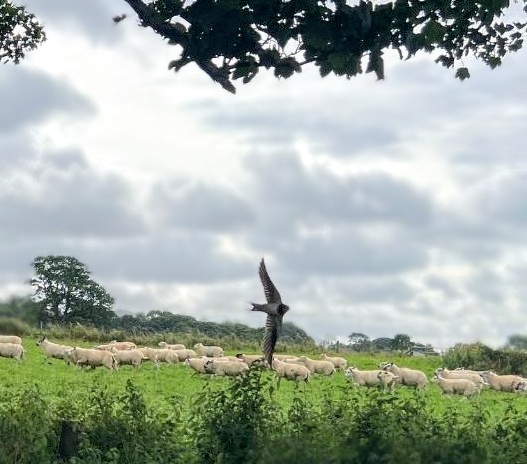
There are still swallows flying over Sandilands, not yet departed for Africa. A few weeks ago, I met up with wildlife artist and avid birder David Cemmick from the local Village. While he was watching the sheep over the newly growing hedge, he snapped one swallow swooping after some tasty insects.
David is helping me identify birds around Sandilands and he explained that right now is a quiet time, that they're moulting after the breeding season and due to this are vulnerable, tending to hide away from predators. The best time to birdwatch is the spring, dawn and dusk, when birds are mating and re-marking territory getting ready for the breeding season.
Which explains the lack of dawn chorus the few times I've stayed over on the land. When I do, I leave the dog's bowl out, full of water. It's always a surprise in the morning. Recently, it was a long dark brown very thin strand which moved! With identification help it turned out to be a horsehair worm. These normally live in aquatic environments and have four stages of egg, the preparasitic larva that hatches from the egg, the parasitic larva that develops within an invertebrate (its host), and the free-living aquatic adult. So the more developed larva need an insect host.
More from the Wildlife Trust website:
"Once inside the host the larvae live inside the primary body cavity....and feed on nutrients inside the host absorbing them directly through their skin and moulting as they grow. It may take a couple of weeks to months to complete the parasitic stage. This process rarely kills the host as the parasite relies on the host’s nutrients. The horsehair worm needs to ensure the host is near water before emerging as an adult.
This leads to the most famous trait of some species of horsehair worms, the ability to highjack the terrestrial host’s nervous system, altering their behaviour to make them actively seek out water. Spinochordodes tellinii and Paragordius tricuspidatus species achieve this by causing grasshopper and crickets to jump into waterbodies drowning themselves when the horsehair worm reaches its adult stage. Once it encounters water, the horsehair worm burrows from the body to return to water to breed, killing the host if not drowned already."
Yes, it's the inspiration to many horror films in my dog bowl. By the way, they are completely harmless to humans.
To get a sense of this place I'm going to be undertaking plant, insect and soil surveys over the next few weeks and and a moth survey too, as I've seen the pupae on the newly planted trees, also glimpsing a chimney sweep moth recently which feeds on pignut growing in the sward, the vegetative skin of this land.

